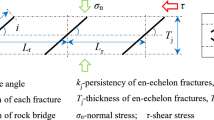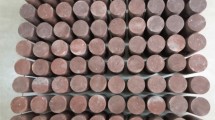Abstract
The prime objective of this work is to provide a reference to predict the peak shear strength of rock fractures. The paper studied some shear properties of rock fractures and proposed an empirical formula for the peak shear strength of rock fractures based on 3D morphology parameters. The rock fractures were induced in cylindrical sandstone and marble specimens by means of indirect tension. A rock direct shear apparatus (RDS-200) was adopted to conduct direct shear tests on five groups of rock fractures under different levels of normal load. Before the direct shear test, 3D morphology parameters of rock fracture surfaces were obtained using a 3D optical scanner. By analyses of direct shear test data, the relationships between peak shear strength, peak shear displacement, peak dilatancy angle, residual friction coefficient and peak normal stress were found. According to the evolution trends of peak shear strength and peak dilatancy angle along with the normal stress, an empirical formula was proposed to predict the peak shear strength of rock fractures in both sliding and cutting failure modes considering the 3D morphology parameters of rock fracture surfaces. The empirical formula could be commonly used for different types (sandstone and marble) and grain sizes (powder-grained, fine-grained, medium-grained and coarse-grained) of rock fractures.












Similar content being viewed by others
References
Amadei B, Wibowo J, Sture S, Price RH (1998) Applicability of existing models to predict the behaviour of replicas of natural fractures of welded tuff under different boundary conditions. Geotech Geol Eng 16(2):79–128
Asadollahi P (2009) Stability analysis of a single three dimensional rock block: effect of dilatancy and high-velocity water jet impact. Dissertation, University of Texas at Austin
Bandis S, Lumsden AC, Barton N (1981) Experimental studies of scale effects on the shear behavior rock joints. Int J Rock Mech Min 18:1–21
Bandis S, Lumsden AC, Barton N (1983) Fundamentals of rock joint deformation. Int J Rock Mech Min 20:249–268. doi:10.1016/0148-9062(83)90595-8
Barton N (1973) Review of a new shear-strength criterion for rock joints. Eng Geol 7(4):287–332. doi:10.1016/0013-7952(73)90013-6
Barton N (1982) Modelling rock joint behavior from in situ block tests: implications for nuclear waste repository design. Columbus: Office of Nuclear Waste Isolation
Barton N, Bandis S (1982) Effect of block size on the shear behavior of jointed rocks. In: Proceedings of the 23rd US symposium on rock mechanics, Berkeley, pp 25–27
Barton N, Bandis S (1990) Review of predictive capabilities of JRC-JCS model in engineering practice. In: Proceedings of international conference on rock joints, Rotterdam, Netherlands; pp 603–610
Barton N, Choubey V (1977) The shear strength of rock joints in theory and practice. Rock Mech Rock Eng 10(10):1–54. doi:10.1007/bf()1261801
Barton N, Bandis S, Bakhtar K (1985) Strength deformation and conductivity coupling of rock joints. Int J Rock Mech Min 22:121–140
Goodman RE (1974) The mechanical property of joints. In: Proceedings of the 3rd congress ISRM. Denver, pp 127–140
Grasselli G (2001) Shear strength of rock joints based on quantified surface description. Dissertation University of Parma
Grasselli G (2006) Manuel Rocha Medal Recipient Shear strength of rock joints based on quantified surface description. Rock Mech Rock Eng 39(4):295–314
Grasselli G, Egger P (2003) Constitutive law for the shear strength of rock joints based on three-dimensional surface parameters. Int J Rock Mech Min 40(1):25–40. doi:10.1016/S1365-1609(02)00101-6
Grasselli G, Wirth J, Egger P (2002) Quantitative three-dimensional description of a rough surface and parameter evolution with shearing. Int J Rock Mech Min 39:789–800
Jing L, Stephansson O, Nordlund E (1993) Study of rock joints under cyclic loading conditions. Rock Mech Rock Eng 26(3):215–232
Johansson F (2015) Influence of scale and matedness on the peak shear strength of fresh, unweathered rock joints. Int J Rock Mech Min 82:36–47
Johansson F, Stille H (2014) A conceptual model for the peak shear strength of fresh and unweathered rock joints. Int J Rock Mech Min 69:31–38. doi:10.1016/j.ijrmms.2014.03.005
Kulatilake PHSW, Shou G, Huang TH, Morgan RM (1995) New peak shear strength criteria for anisotropic rock joints. Int J Rock Mech Min 32(7):673–697. doi:10.1016/0148-9062(95)00022-9
Kusumi H, Teraoka K, Nishida K (1997) Study on new formulation of shear strength for irregular rock joint. Int J Rock Mech Min 34(s3–4):168.e1–168.e15. doi:10.1016/S1365-1609(97)00029-4
Ladanyi B, Archambault G (1970) Simulation of the shear behavior of a jointed rock mass. In: Proceedings of the 11th US symposium on rock mechanics. Berkeley, pp 105–125
Lee YH, Carr JR, Barr DJ, Haas CJ (1990) The fractal dimension as a measure of the roughness of rock discontinuity profiles. Int J Rock Mech Min 27(6):453–464
Lee YK, Park JW, Song JJ (2014) Model for the shear behavior of rock joints under CNL and CNS conditions. Int J Rock Mech Min 70:252–263. doi:10.1016/j.ijrmms.2014.05.005
Li Y, Zhang Y (2015) Quantitative estimation of joint roughness coefficient using statistical parameters. Int J Rock Mech Min 77:27–35
Li HB, Liu B, Feng HP, Zhang LQ (2008) Study of deformability behavior and failure mechanism by simulating rock joints sample under different loading conditions. Rock Soil Mech 29(7):1741–1752
Li WF, Bai JB, Chen JY, Peng Syd, Liu HL (2015) Determination of coal–rock interface strength by laboratory direct shear tests under constant normal load. Int J Rock Mech Min 77:60–67. doi:10.1016/j.ijrmms.2015.03.033
Maerz NH, Fanklin JA, Bennett CP (1990) Joint roughness measurement using shadow profilometry. Int J Rock Mech Min 27(5):329–343
Maksimović M (1992) New description of the shear strength for rock joints. Rock Mech Rock Eng 25(4):275–284
Patton FD (1966) Multiple modes of shear failure in rock. In: Proceedings of the first congress of international society of rock mechanics, Lisbon, pp 509–513
Plesha ME (1987) Constitutive models for rock discontinuities with dilatancy and surface degradation. Int J Numer Anal Methods Geomech 11(4):345–362
Reeves MJ (1985) Rock surface roughness and frictional strength. Int J Rock Mech Min 22(6):429–442
Saeb S, Amadei B (1992) Modelling rock joints under shear and normal loading. Int J Rock Mech Min 29(3):267–278. doi:10.1016/0148-9062(92)91657-Q
Sanei M, Faramarzi L, Goli S, Fahimifar A, Rahmati A, Mehinrad A (2015) Development of a new equation for joint roughness coefficient (JRC) with fractal dimension: a case study of Bakhtiary Dam site in Iran. Arab J Geosci 8:465–475
Seidel JP, Haberfield CM (2002) A theoretical model for rock joints subjected to constant normal stiffness direct shear. Int J Rock Mech Min 39(5):539–553. doi:10.1016/S1365-1609(02)00056-4
Serrano A, Olalla C, Galindo RA (2014) Micromechanical basis for shear strength of rock discontinuities. Int J Rock Mech Min 70:33–46. doi:10.1016/j.ijrmms.2014.02.021
Shang Z, Wei JH (2013) Impaction of structural plane roughness on deformation character and strength character. J Beihua Univ (Nat Sci) 14(6):744–748
Tang ZC, Liu QS (2015) Shear strength criterion and shear components of rock joints I: shear strength criterion. Chin J Geotech Eng 37(2):292–298
Tse R, Cruden DM (1979) Estimating joint roughness coefficient. Int J Rock Mech Min 16:303–307
Wang JA, Wang YX, Cao QJ, Ju Y, Mao LT (2015) Behavior of microcontacts in rock joints under direct shear creep loading. Int J Rock Mech Min 78:217–229. doi:10.1016/j.ijrmms.2015.05.002
Wang CL, Guo BH, Wang L (2016) Experimental study on relationship between mechanical, seepage characteristics and 3D morphology parameters of marble joint. Open Civil Eng J 10:513–523
Wibowo J (1994) Effect of boundary conditions and surface damage on the shear behavior of rock joints: tests and analytical predictions. Dissertation, University of Colorado
Xia CC, Tang ZC, Song YL (2013) A new peak shear strength formula for matching irregular joints based on 3D morphology parameters. Chin J Rock Mech Eng 32(supp. 1):2833–2839
Xia CC, Tang ZC, Xiao WM, Song YL (2014) New peak shear strength criterion of rock joints based on quantified surface description. Rock Mech Rock Eng 47(2):387–400
Xie HP, Wang JA, Kwasniewski MA (1999) Multifractal characterization of rock fracture surfaces. Int J Rock Mech Min 36:19–27
Zheng B, Qi S (2016) A new index to describe joint roughness coefficient (JRC) under cyclic shear. Eng Geol 212:72–85
Acknowledgments
This research is supported by the China National Natural Science Foundation (Project Nos. 51109076) and the key scientific and technological project of Henan Province (152102210316). The authors declare that they have no conflict of interest.
Author information
Authors and Affiliations
Corresponding author
Rights and permissions
About this article
Cite this article
Dong, H., Guo, B., Li, Y. et al. Empirical Formula of Shear Strength of Rock Fractures Based on 3D Morphology Parameters. Geotech Geol Eng 35, 1169–1183 (2017). https://doi.org/10.1007/s10706-017-0172-5
Received:
Accepted:
Published:
Issue Date:
DOI: https://doi.org/10.1007/s10706-017-0172-5




